PGBM16 Global Corporate Strategy: A Case Study of Tata Group's Growth
VerifiedAdded on 2023/06/04
|17
|4563
|51
Case Study
AI Summary
This case study analyzes Tata Group's global corporate strategy, focusing on its growth strategies within the global steel manufacturing industry. It examines the challenges faced by Tata Steel, including regulatory changes and competition from China, while highlighting the company's growth and investments. The report outlines the theories and strategies adopted by Tata Group, demonstrating their application in solving industrial issues and analyzing Tata’s strategic processes. It also evaluates the company's competitiveness, integrated perspectives, technological and business model innovation through strategic alliances, leadership, sustainability, and corporate governance. The analysis includes the impact of projects like Corus and the implementation of technologies like Ms. SharePoint, alongside cost-efficiency measures during economic crises. The study concludes by summarizing Tata's mission, policies, and objectives in the global market.
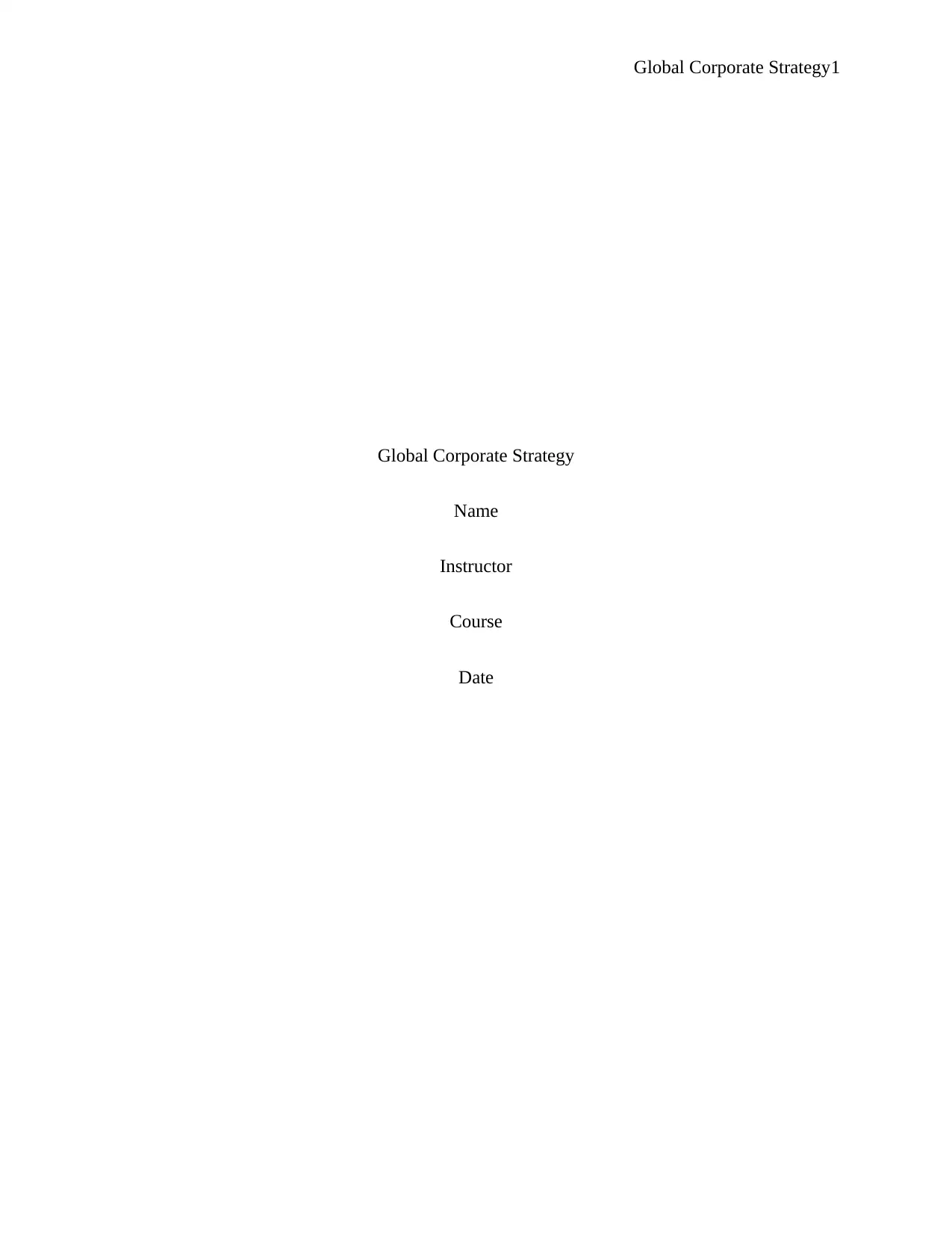
Global Corporate Strategy1
Global Corporate Strategy
Name
Instructor
Course
Date
Global Corporate Strategy
Name
Instructor
Course
Date
Paraphrase This Document
Need a fresh take? Get an instant paraphrase of this document with our AI Paraphraser
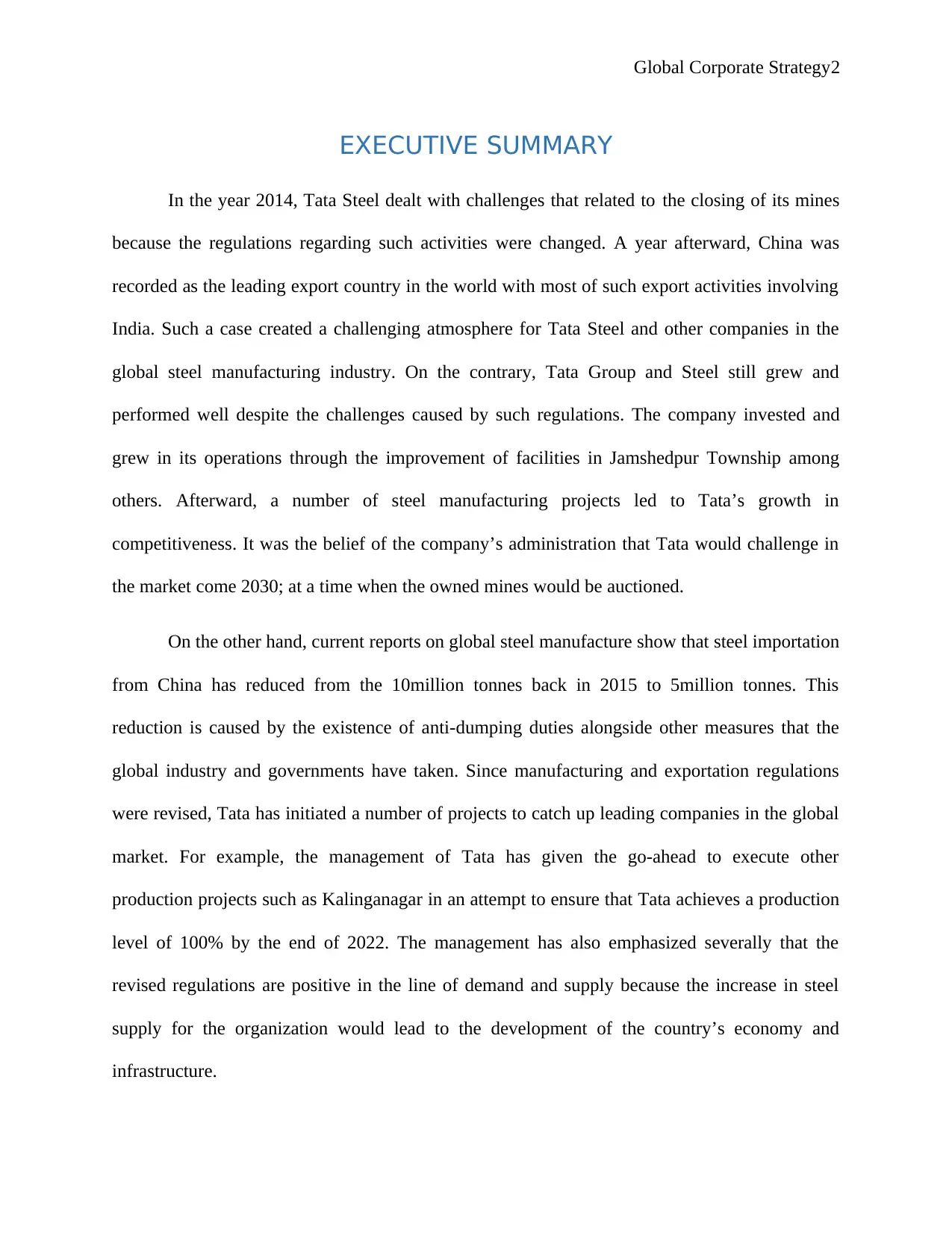
Global Corporate Strategy2
EXECUTIVE SUMMARY
In the year 2014, Tata Steel dealt with challenges that related to the closing of its mines
because the regulations regarding such activities were changed. A year afterward, China was
recorded as the leading export country in the world with most of such export activities involving
India. Such a case created a challenging atmosphere for Tata Steel and other companies in the
global steel manufacturing industry. On the contrary, Tata Group and Steel still grew and
performed well despite the challenges caused by such regulations. The company invested and
grew in its operations through the improvement of facilities in Jamshedpur Township among
others. Afterward, a number of steel manufacturing projects led to Tata’s growth in
competitiveness. It was the belief of the company’s administration that Tata would challenge in
the market come 2030; at a time when the owned mines would be auctioned.
On the other hand, current reports on global steel manufacture show that steel importation
from China has reduced from the 10million tonnes back in 2015 to 5million tonnes. This
reduction is caused by the existence of anti-dumping duties alongside other measures that the
global industry and governments have taken. Since manufacturing and exportation regulations
were revised, Tata has initiated a number of projects to catch up leading companies in the global
market. For example, the management of Tata has given the go-ahead to execute other
production projects such as Kalinganagar in an attempt to ensure that Tata achieves a production
level of 100% by the end of 2022. The management has also emphasized severally that the
revised regulations are positive in the line of demand and supply because the increase in steel
supply for the organization would lead to the development of the country’s economy and
infrastructure.
EXECUTIVE SUMMARY
In the year 2014, Tata Steel dealt with challenges that related to the closing of its mines
because the regulations regarding such activities were changed. A year afterward, China was
recorded as the leading export country in the world with most of such export activities involving
India. Such a case created a challenging atmosphere for Tata Steel and other companies in the
global steel manufacturing industry. On the contrary, Tata Group and Steel still grew and
performed well despite the challenges caused by such regulations. The company invested and
grew in its operations through the improvement of facilities in Jamshedpur Township among
others. Afterward, a number of steel manufacturing projects led to Tata’s growth in
competitiveness. It was the belief of the company’s administration that Tata would challenge in
the market come 2030; at a time when the owned mines would be auctioned.
On the other hand, current reports on global steel manufacture show that steel importation
from China has reduced from the 10million tonnes back in 2015 to 5million tonnes. This
reduction is caused by the existence of anti-dumping duties alongside other measures that the
global industry and governments have taken. Since manufacturing and exportation regulations
were revised, Tata has initiated a number of projects to catch up leading companies in the global
market. For example, the management of Tata has given the go-ahead to execute other
production projects such as Kalinganagar in an attempt to ensure that Tata achieves a production
level of 100% by the end of 2022. The management has also emphasized severally that the
revised regulations are positive in the line of demand and supply because the increase in steel
supply for the organization would lead to the development of the country’s economy and
infrastructure.
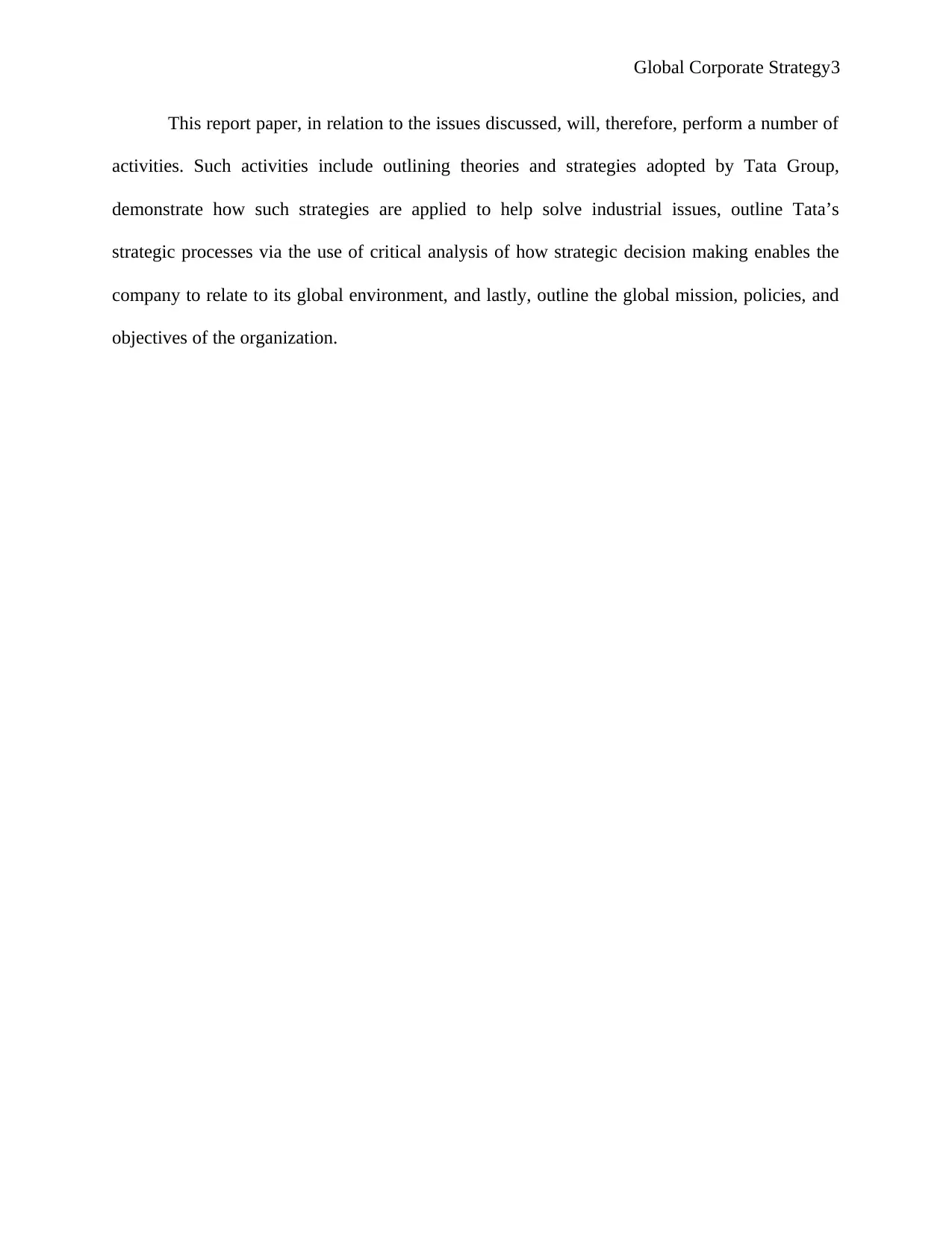
Global Corporate Strategy3
This report paper, in relation to the issues discussed, will, therefore, perform a number of
activities. Such activities include outlining theories and strategies adopted by Tata Group,
demonstrate how such strategies are applied to help solve industrial issues, outline Tata’s
strategic processes via the use of critical analysis of how strategic decision making enables the
company to relate to its global environment, and lastly, outline the global mission, policies, and
objectives of the organization.
This report paper, in relation to the issues discussed, will, therefore, perform a number of
activities. Such activities include outlining theories and strategies adopted by Tata Group,
demonstrate how such strategies are applied to help solve industrial issues, outline Tata’s
strategic processes via the use of critical analysis of how strategic decision making enables the
company to relate to its global environment, and lastly, outline the global mission, policies, and
objectives of the organization.
⊘ This is a preview!⊘
Do you want full access?
Subscribe today to unlock all pages.

Trusted by 1+ million students worldwide
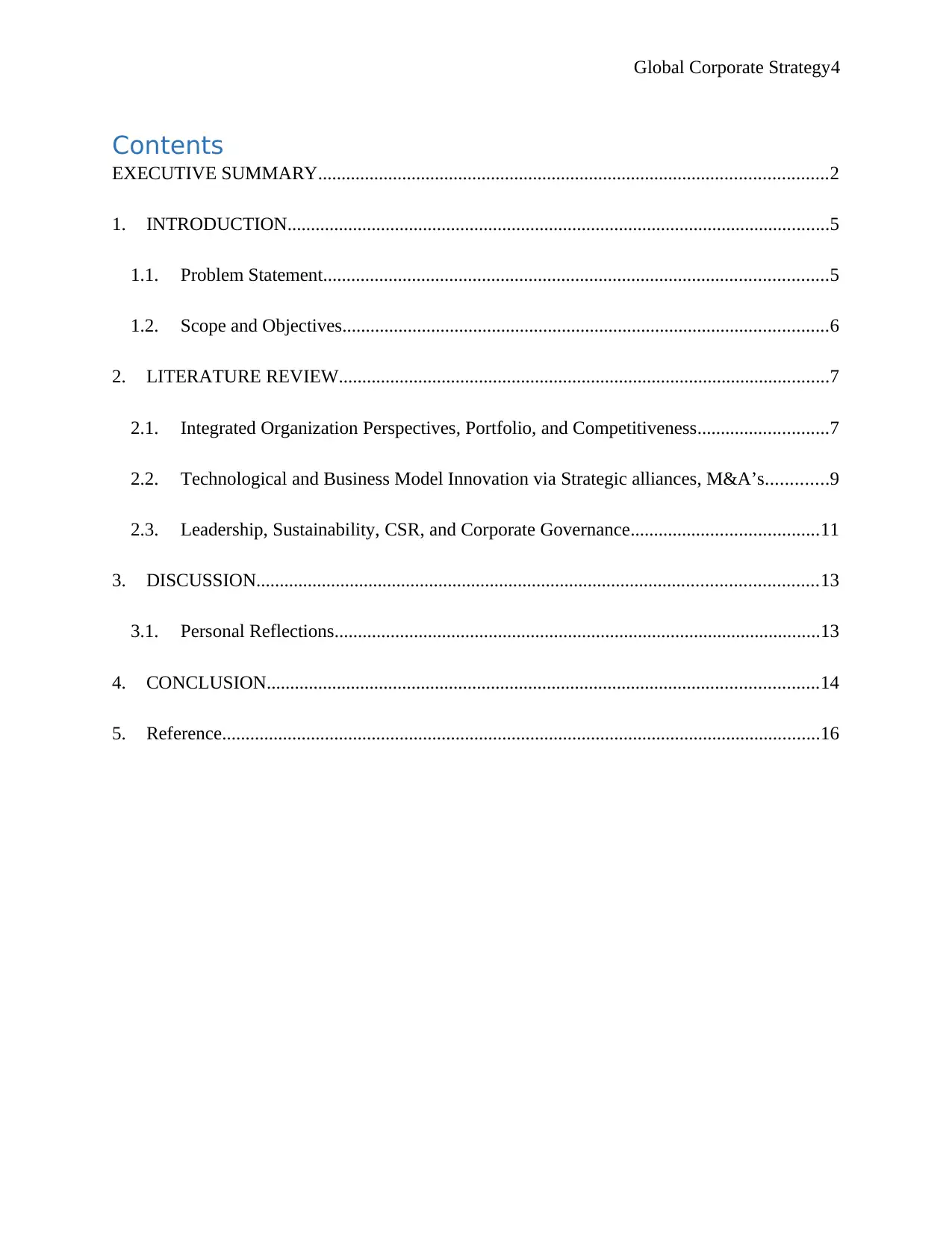
Global Corporate Strategy4
Contents
EXECUTIVE SUMMARY.............................................................................................................2
1. INTRODUCTION....................................................................................................................5
1.1. Problem Statement............................................................................................................5
1.2. Scope and Objectives........................................................................................................6
2. LITERATURE REVIEW.........................................................................................................7
2.1. Integrated Organization Perspectives, Portfolio, and Competitiveness............................7
2.2. Technological and Business Model Innovation via Strategic alliances, M&A’s.............9
2.3. Leadership, Sustainability, CSR, and Corporate Governance........................................11
3. DISCUSSION........................................................................................................................13
3.1. Personal Reflections........................................................................................................13
4. CONCLUSION......................................................................................................................14
5. Reference................................................................................................................................16
Contents
EXECUTIVE SUMMARY.............................................................................................................2
1. INTRODUCTION....................................................................................................................5
1.1. Problem Statement............................................................................................................5
1.2. Scope and Objectives........................................................................................................6
2. LITERATURE REVIEW.........................................................................................................7
2.1. Integrated Organization Perspectives, Portfolio, and Competitiveness............................7
2.2. Technological and Business Model Innovation via Strategic alliances, M&A’s.............9
2.3. Leadership, Sustainability, CSR, and Corporate Governance........................................11
3. DISCUSSION........................................................................................................................13
3.1. Personal Reflections........................................................................................................13
4. CONCLUSION......................................................................................................................14
5. Reference................................................................................................................................16
Paraphrase This Document
Need a fresh take? Get an instant paraphrase of this document with our AI Paraphraser
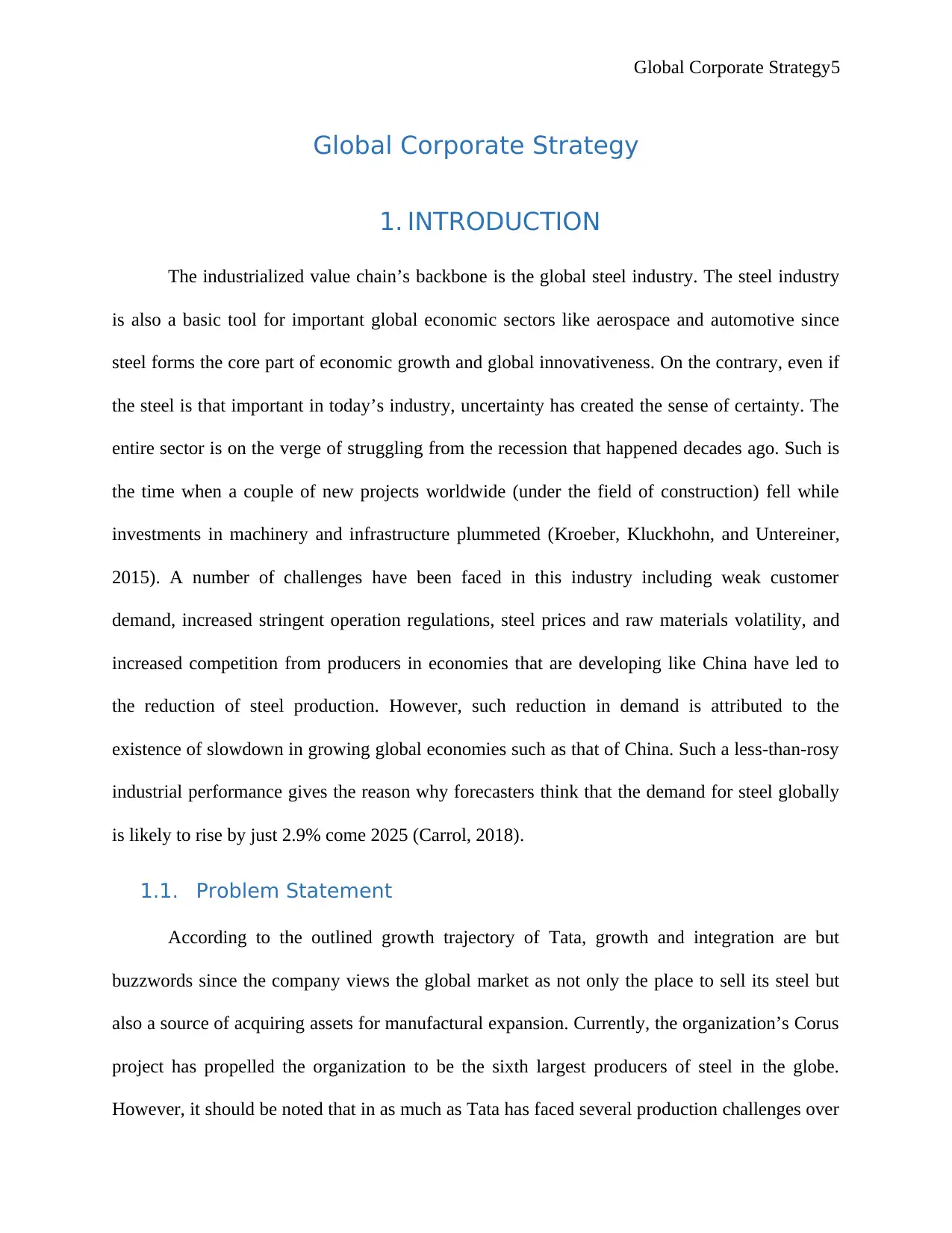
Global Corporate Strategy5
Global Corporate Strategy
1. INTRODUCTION
The industrialized value chain’s backbone is the global steel industry. The steel industry
is also a basic tool for important global economic sectors like aerospace and automotive since
steel forms the core part of economic growth and global innovativeness. On the contrary, even if
the steel is that important in today’s industry, uncertainty has created the sense of certainty. The
entire sector is on the verge of struggling from the recession that happened decades ago. Such is
the time when a couple of new projects worldwide (under the field of construction) fell while
investments in machinery and infrastructure plummeted (Kroeber, Kluckhohn, and Untereiner,
2015). A number of challenges have been faced in this industry including weak customer
demand, increased stringent operation regulations, steel prices and raw materials volatility, and
increased competition from producers in economies that are developing like China have led to
the reduction of steel production. However, such reduction in demand is attributed to the
existence of slowdown in growing global economies such as that of China. Such a less-than-rosy
industrial performance gives the reason why forecasters think that the demand for steel globally
is likely to rise by just 2.9% come 2025 (Carrol, 2018).
1.1. Problem Statement
According to the outlined growth trajectory of Tata, growth and integration are but
buzzwords since the company views the global market as not only the place to sell its steel but
also a source of acquiring assets for manufactural expansion. Currently, the organization’s Corus
project has propelled the organization to be the sixth largest producers of steel in the globe.
However, it should be noted that in as much as Tata has faced several production challenges over
Global Corporate Strategy
1. INTRODUCTION
The industrialized value chain’s backbone is the global steel industry. The steel industry
is also a basic tool for important global economic sectors like aerospace and automotive since
steel forms the core part of economic growth and global innovativeness. On the contrary, even if
the steel is that important in today’s industry, uncertainty has created the sense of certainty. The
entire sector is on the verge of struggling from the recession that happened decades ago. Such is
the time when a couple of new projects worldwide (under the field of construction) fell while
investments in machinery and infrastructure plummeted (Kroeber, Kluckhohn, and Untereiner,
2015). A number of challenges have been faced in this industry including weak customer
demand, increased stringent operation regulations, steel prices and raw materials volatility, and
increased competition from producers in economies that are developing like China have led to
the reduction of steel production. However, such reduction in demand is attributed to the
existence of slowdown in growing global economies such as that of China. Such a less-than-rosy
industrial performance gives the reason why forecasters think that the demand for steel globally
is likely to rise by just 2.9% come 2025 (Carrol, 2018).
1.1. Problem Statement
According to the outlined growth trajectory of Tata, growth and integration are but
buzzwords since the company views the global market as not only the place to sell its steel but
also a source of acquiring assets for manufactural expansion. Currently, the organization’s Corus
project has propelled the organization to be the sixth largest producers of steel in the globe.
However, it should be noted that in as much as Tata has faced several production challenges over
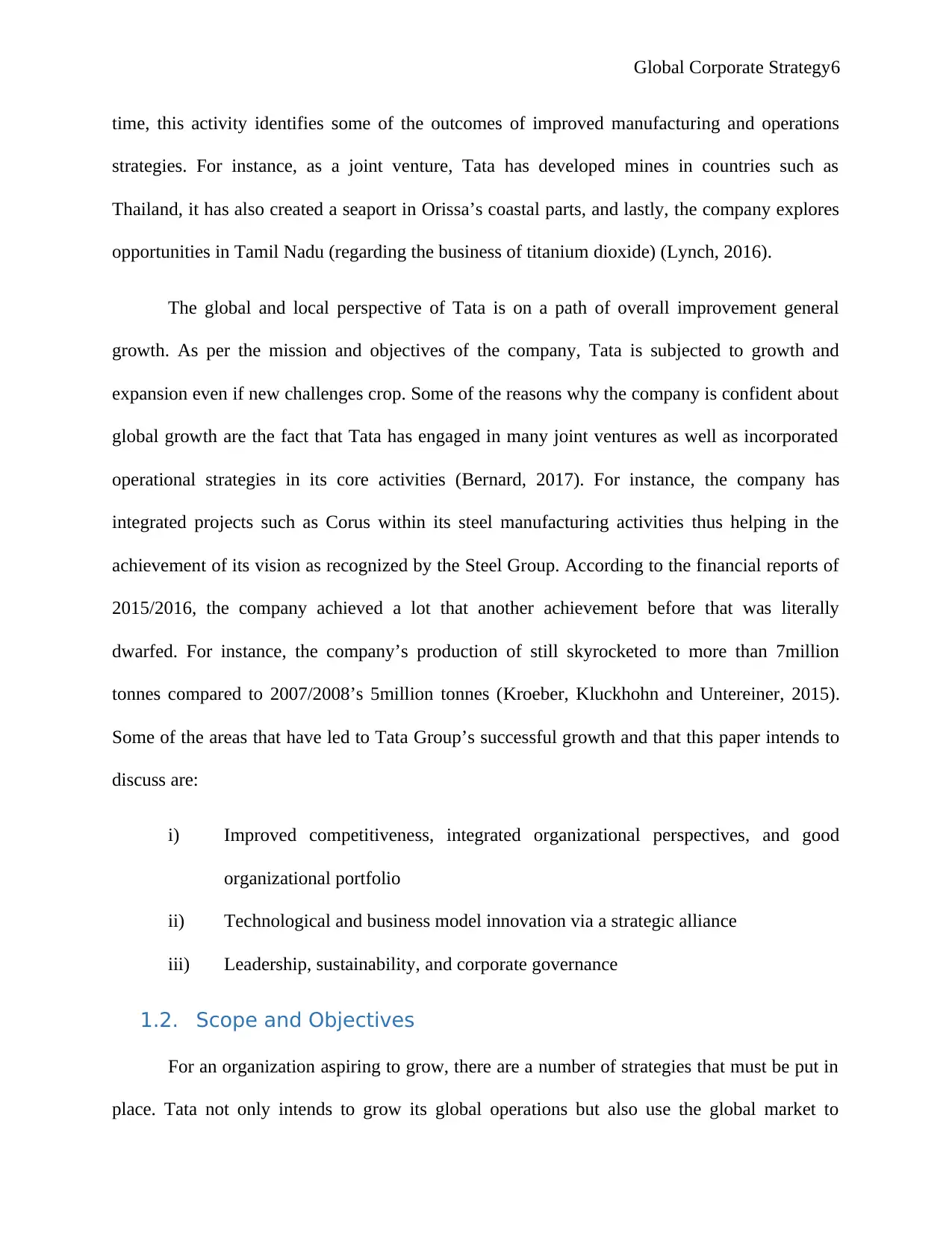
Global Corporate Strategy6
time, this activity identifies some of the outcomes of improved manufacturing and operations
strategies. For instance, as a joint venture, Tata has developed mines in countries such as
Thailand, it has also created a seaport in Orissa’s coastal parts, and lastly, the company explores
opportunities in Tamil Nadu (regarding the business of titanium dioxide) (Lynch, 2016).
The global and local perspective of Tata is on a path of overall improvement general
growth. As per the mission and objectives of the company, Tata is subjected to growth and
expansion even if new challenges crop. Some of the reasons why the company is confident about
global growth are the fact that Tata has engaged in many joint ventures as well as incorporated
operational strategies in its core activities (Bernard, 2017). For instance, the company has
integrated projects such as Corus within its steel manufacturing activities thus helping in the
achievement of its vision as recognized by the Steel Group. According to the financial reports of
2015/2016, the company achieved a lot that another achievement before that was literally
dwarfed. For instance, the company’s production of still skyrocketed to more than 7million
tonnes compared to 2007/2008’s 5million tonnes (Kroeber, Kluckhohn and Untereiner, 2015).
Some of the areas that have led to Tata Group’s successful growth and that this paper intends to
discuss are:
i) Improved competitiveness, integrated organizational perspectives, and good
organizational portfolio
ii) Technological and business model innovation via a strategic alliance
iii) Leadership, sustainability, and corporate governance
1.2. Scope and Objectives
For an organization aspiring to grow, there are a number of strategies that must be put in
place. Tata not only intends to grow its global operations but also use the global market to
time, this activity identifies some of the outcomes of improved manufacturing and operations
strategies. For instance, as a joint venture, Tata has developed mines in countries such as
Thailand, it has also created a seaport in Orissa’s coastal parts, and lastly, the company explores
opportunities in Tamil Nadu (regarding the business of titanium dioxide) (Lynch, 2016).
The global and local perspective of Tata is on a path of overall improvement general
growth. As per the mission and objectives of the company, Tata is subjected to growth and
expansion even if new challenges crop. Some of the reasons why the company is confident about
global growth are the fact that Tata has engaged in many joint ventures as well as incorporated
operational strategies in its core activities (Bernard, 2017). For instance, the company has
integrated projects such as Corus within its steel manufacturing activities thus helping in the
achievement of its vision as recognized by the Steel Group. According to the financial reports of
2015/2016, the company achieved a lot that another achievement before that was literally
dwarfed. For instance, the company’s production of still skyrocketed to more than 7million
tonnes compared to 2007/2008’s 5million tonnes (Kroeber, Kluckhohn and Untereiner, 2015).
Some of the areas that have led to Tata Group’s successful growth and that this paper intends to
discuss are:
i) Improved competitiveness, integrated organizational perspectives, and good
organizational portfolio
ii) Technological and business model innovation via a strategic alliance
iii) Leadership, sustainability, and corporate governance
1.2. Scope and Objectives
For an organization aspiring to grow, there are a number of strategies that must be put in
place. Tata not only intends to grow its global operations but also use the global market to
⊘ This is a preview!⊘
Do you want full access?
Subscribe today to unlock all pages.

Trusted by 1+ million students worldwide
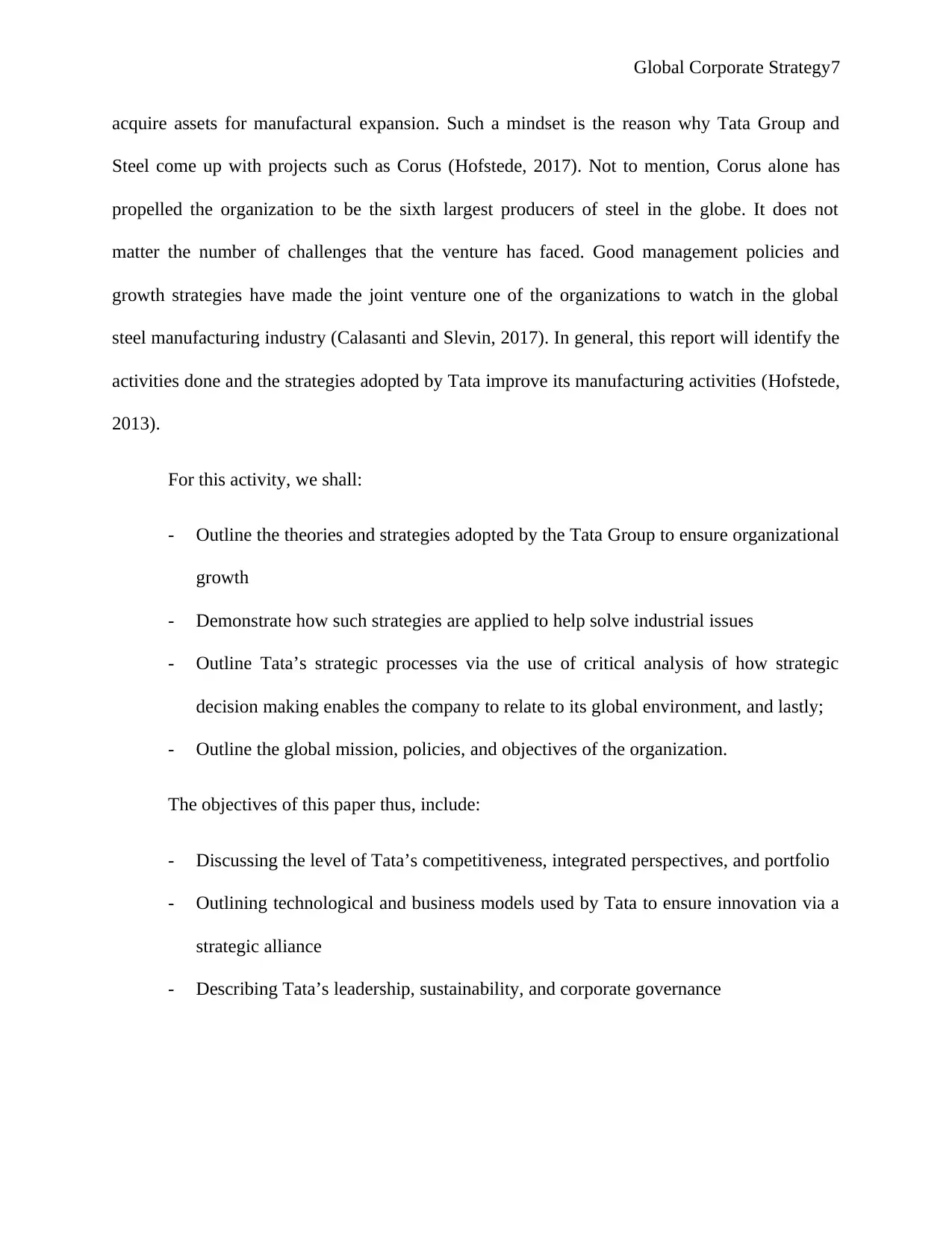
Global Corporate Strategy7
acquire assets for manufactural expansion. Such a mindset is the reason why Tata Group and
Steel come up with projects such as Corus (Hofstede, 2017). Not to mention, Corus alone has
propelled the organization to be the sixth largest producers of steel in the globe. It does not
matter the number of challenges that the venture has faced. Good management policies and
growth strategies have made the joint venture one of the organizations to watch in the global
steel manufacturing industry (Calasanti and Slevin, 2017). In general, this report will identify the
activities done and the strategies adopted by Tata improve its manufacturing activities (Hofstede,
2013).
For this activity, we shall:
- Outline the theories and strategies adopted by the Tata Group to ensure organizational
growth
- Demonstrate how such strategies are applied to help solve industrial issues
- Outline Tata’s strategic processes via the use of critical analysis of how strategic
decision making enables the company to relate to its global environment, and lastly;
- Outline the global mission, policies, and objectives of the organization.
The objectives of this paper thus, include:
- Discussing the level of Tata’s competitiveness, integrated perspectives, and portfolio
- Outlining technological and business models used by Tata to ensure innovation via a
strategic alliance
- Describing Tata’s leadership, sustainability, and corporate governance
acquire assets for manufactural expansion. Such a mindset is the reason why Tata Group and
Steel come up with projects such as Corus (Hofstede, 2017). Not to mention, Corus alone has
propelled the organization to be the sixth largest producers of steel in the globe. It does not
matter the number of challenges that the venture has faced. Good management policies and
growth strategies have made the joint venture one of the organizations to watch in the global
steel manufacturing industry (Calasanti and Slevin, 2017). In general, this report will identify the
activities done and the strategies adopted by Tata improve its manufacturing activities (Hofstede,
2013).
For this activity, we shall:
- Outline the theories and strategies adopted by the Tata Group to ensure organizational
growth
- Demonstrate how such strategies are applied to help solve industrial issues
- Outline Tata’s strategic processes via the use of critical analysis of how strategic
decision making enables the company to relate to its global environment, and lastly;
- Outline the global mission, policies, and objectives of the organization.
The objectives of this paper thus, include:
- Discussing the level of Tata’s competitiveness, integrated perspectives, and portfolio
- Outlining technological and business models used by Tata to ensure innovation via a
strategic alliance
- Describing Tata’s leadership, sustainability, and corporate governance
Paraphrase This Document
Need a fresh take? Get an instant paraphrase of this document with our AI Paraphraser
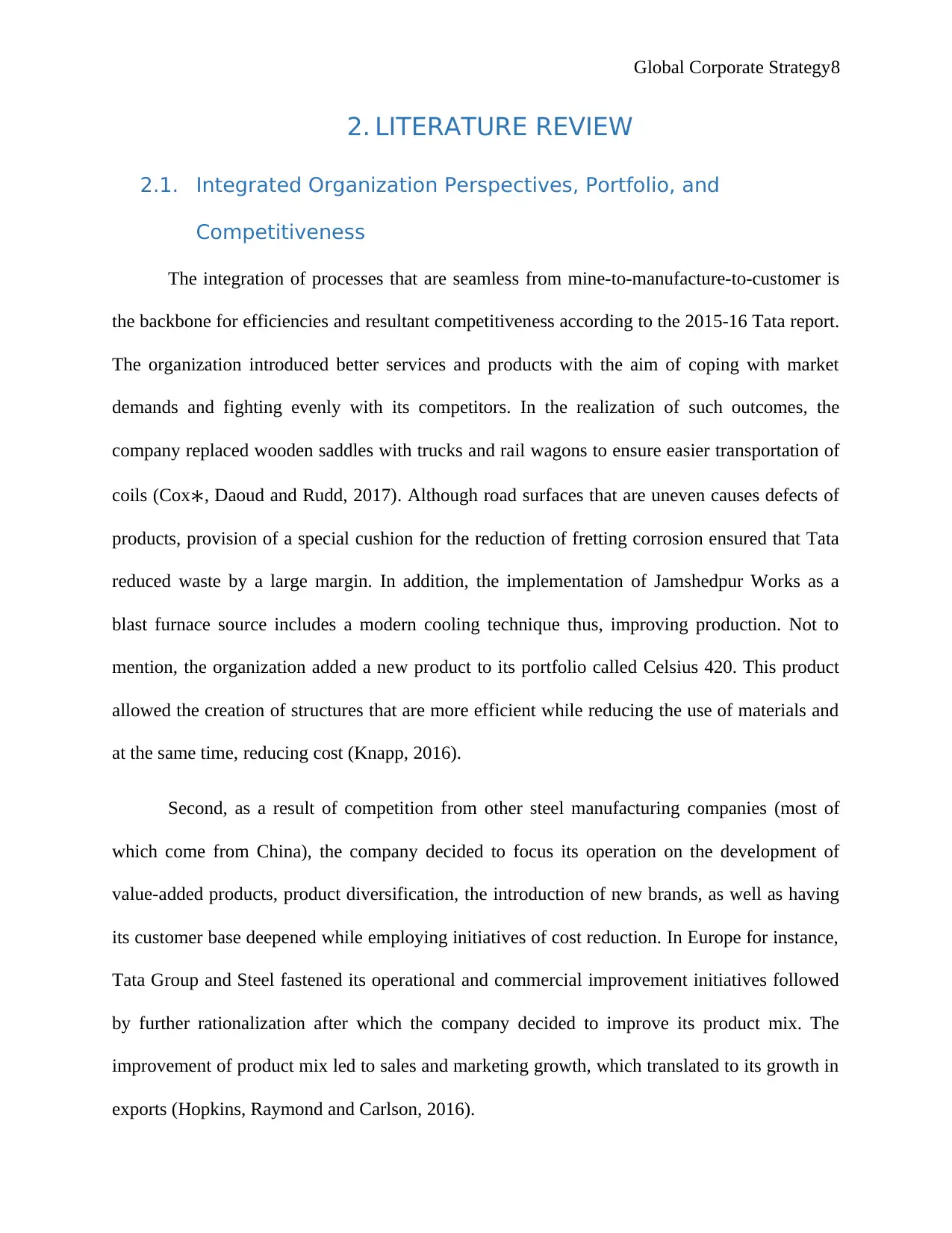
Global Corporate Strategy8
2. LITERATURE REVIEW
2.1. Integrated Organization Perspectives, Portfolio, and
Competitiveness
The integration of processes that are seamless from mine-to-manufacture-to-customer is
the backbone for efficiencies and resultant competitiveness according to the 2015-16 Tata report.
The organization introduced better services and products with the aim of coping with market
demands and fighting evenly with its competitors. In the realization of such outcomes, the
company replaced wooden saddles with trucks and rail wagons to ensure easier transportation of
coils (Cox∗, Daoud and Rudd, 2017). Although road surfaces that are uneven causes defects of
products, provision of a special cushion for the reduction of fretting corrosion ensured that Tata
reduced waste by a large margin. In addition, the implementation of Jamshedpur Works as a
blast furnace source includes a modern cooling technique thus, improving production. Not to
mention, the organization added a new product to its portfolio called Celsius 420. This product
allowed the creation of structures that are more efficient while reducing the use of materials and
at the same time, reducing cost (Knapp, 2016).
Second, as a result of competition from other steel manufacturing companies (most of
which come from China), the company decided to focus its operation on the development of
value-added products, product diversification, the introduction of new brands, as well as having
its customer base deepened while employing initiatives of cost reduction. In Europe for instance,
Tata Group and Steel fastened its operational and commercial improvement initiatives followed
by further rationalization after which the company decided to improve its product mix. The
improvement of product mix led to sales and marketing growth, which translated to its growth in
exports (Hopkins, Raymond and Carlson, 2016).
2. LITERATURE REVIEW
2.1. Integrated Organization Perspectives, Portfolio, and
Competitiveness
The integration of processes that are seamless from mine-to-manufacture-to-customer is
the backbone for efficiencies and resultant competitiveness according to the 2015-16 Tata report.
The organization introduced better services and products with the aim of coping with market
demands and fighting evenly with its competitors. In the realization of such outcomes, the
company replaced wooden saddles with trucks and rail wagons to ensure easier transportation of
coils (Cox∗, Daoud and Rudd, 2017). Although road surfaces that are uneven causes defects of
products, provision of a special cushion for the reduction of fretting corrosion ensured that Tata
reduced waste by a large margin. In addition, the implementation of Jamshedpur Works as a
blast furnace source includes a modern cooling technique thus, improving production. Not to
mention, the organization added a new product to its portfolio called Celsius 420. This product
allowed the creation of structures that are more efficient while reducing the use of materials and
at the same time, reducing cost (Knapp, 2016).
Second, as a result of competition from other steel manufacturing companies (most of
which come from China), the company decided to focus its operation on the development of
value-added products, product diversification, the introduction of new brands, as well as having
its customer base deepened while employing initiatives of cost reduction. In Europe for instance,
Tata Group and Steel fastened its operational and commercial improvement initiatives followed
by further rationalization after which the company decided to improve its product mix. The
improvement of product mix led to sales and marketing growth, which translated to its growth in
exports (Hopkins, Raymond and Carlson, 2016).
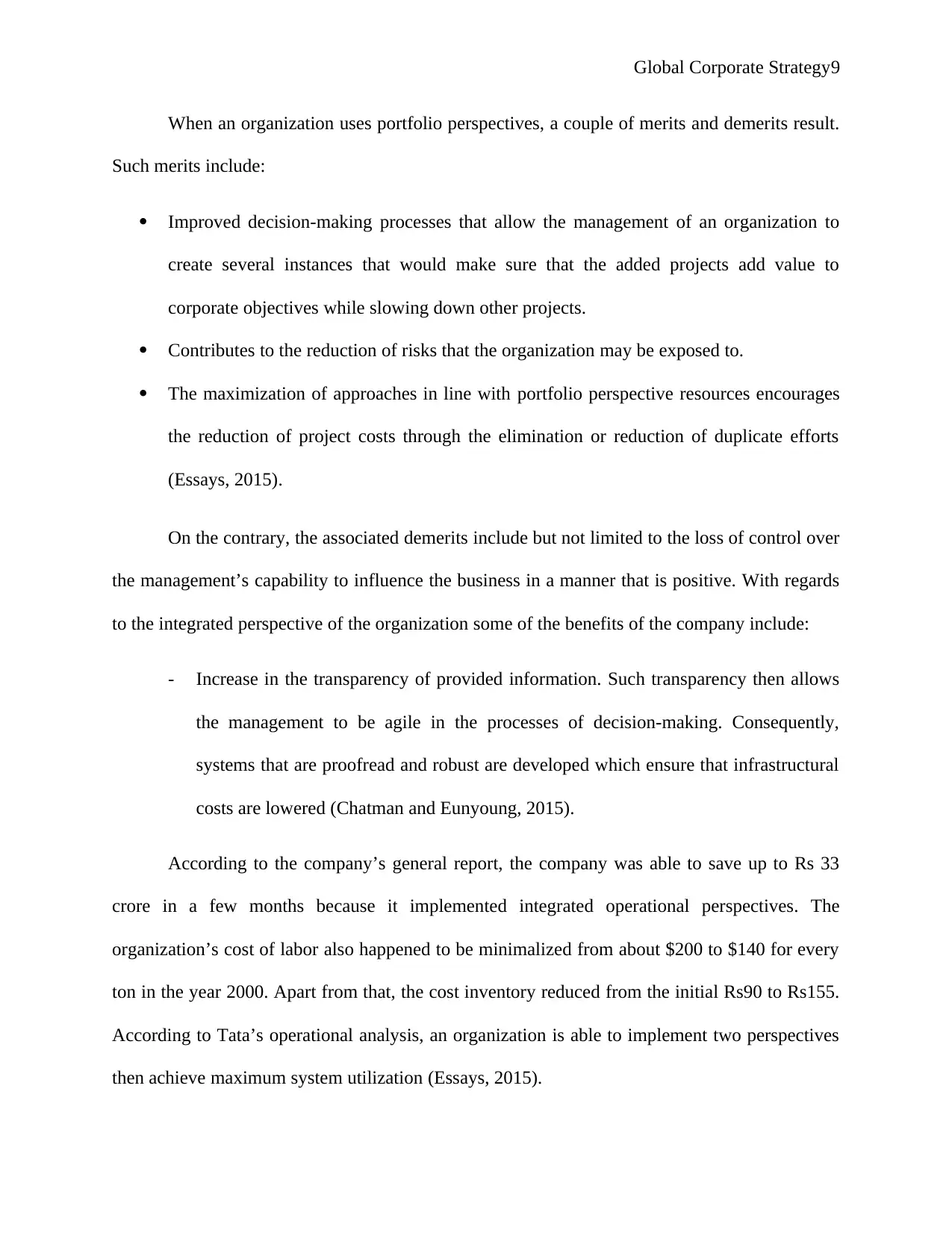
Global Corporate Strategy9
When an organization uses portfolio perspectives, a couple of merits and demerits result.
Such merits include:
Improved decision-making processes that allow the management of an organization to
create several instances that would make sure that the added projects add value to
corporate objectives while slowing down other projects.
Contributes to the reduction of risks that the organization may be exposed to.
The maximization of approaches in line with portfolio perspective resources encourages
the reduction of project costs through the elimination or reduction of duplicate efforts
(Essays, 2015).
On the contrary, the associated demerits include but not limited to the loss of control over
the management’s capability to influence the business in a manner that is positive. With regards
to the integrated perspective of the organization some of the benefits of the company include:
- Increase in the transparency of provided information. Such transparency then allows
the management to be agile in the processes of decision-making. Consequently,
systems that are proofread and robust are developed which ensure that infrastructural
costs are lowered (Chatman and Eunyoung, 2015).
According to the company’s general report, the company was able to save up to Rs 33
crore in a few months because it implemented integrated operational perspectives. The
organization’s cost of labor also happened to be minimalized from about $200 to $140 for every
ton in the year 2000. Apart from that, the cost inventory reduced from the initial Rs90 to Rs155.
According to Tata’s operational analysis, an organization is able to implement two perspectives
then achieve maximum system utilization (Essays, 2015).
When an organization uses portfolio perspectives, a couple of merits and demerits result.
Such merits include:
Improved decision-making processes that allow the management of an organization to
create several instances that would make sure that the added projects add value to
corporate objectives while slowing down other projects.
Contributes to the reduction of risks that the organization may be exposed to.
The maximization of approaches in line with portfolio perspective resources encourages
the reduction of project costs through the elimination or reduction of duplicate efforts
(Essays, 2015).
On the contrary, the associated demerits include but not limited to the loss of control over
the management’s capability to influence the business in a manner that is positive. With regards
to the integrated perspective of the organization some of the benefits of the company include:
- Increase in the transparency of provided information. Such transparency then allows
the management to be agile in the processes of decision-making. Consequently,
systems that are proofread and robust are developed which ensure that infrastructural
costs are lowered (Chatman and Eunyoung, 2015).
According to the company’s general report, the company was able to save up to Rs 33
crore in a few months because it implemented integrated operational perspectives. The
organization’s cost of labor also happened to be minimalized from about $200 to $140 for every
ton in the year 2000. Apart from that, the cost inventory reduced from the initial Rs90 to Rs155.
According to Tata’s operational analysis, an organization is able to implement two perspectives
then achieve maximum system utilization (Essays, 2015).
⊘ This is a preview!⊘
Do you want full access?
Subscribe today to unlock all pages.

Trusted by 1+ million students worldwide
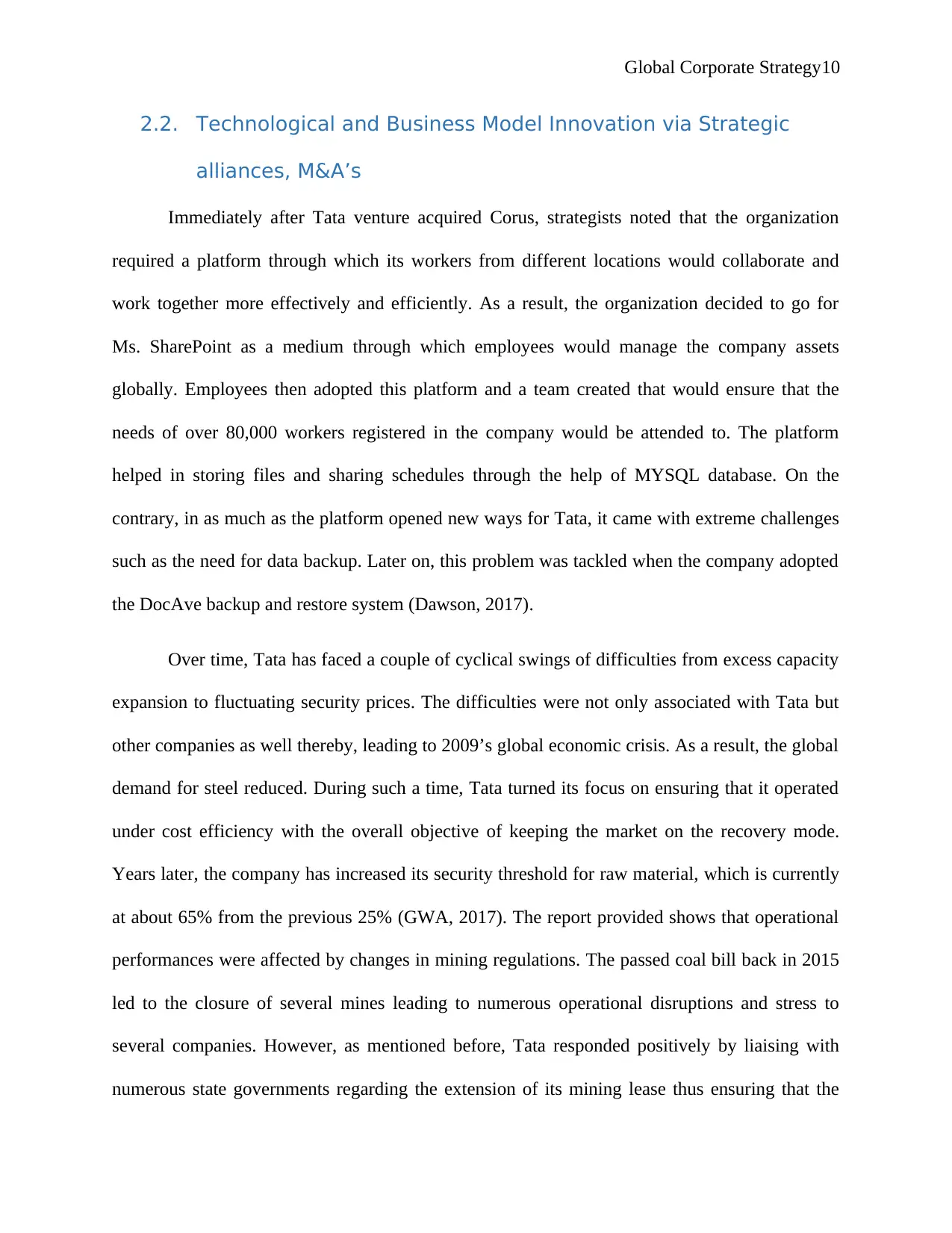
Global Corporate Strategy10
2.2. Technological and Business Model Innovation via Strategic
alliances, M&A’s
Immediately after Tata venture acquired Corus, strategists noted that the organization
required a platform through which its workers from different locations would collaborate and
work together more effectively and efficiently. As a result, the organization decided to go for
Ms. SharePoint as a medium through which employees would manage the company assets
globally. Employees then adopted this platform and a team created that would ensure that the
needs of over 80,000 workers registered in the company would be attended to. The platform
helped in storing files and sharing schedules through the help of MYSQL database. On the
contrary, in as much as the platform opened new ways for Tata, it came with extreme challenges
such as the need for data backup. Later on, this problem was tackled when the company adopted
the DocAve backup and restore system (Dawson, 2017).
Over time, Tata has faced a couple of cyclical swings of difficulties from excess capacity
expansion to fluctuating security prices. The difficulties were not only associated with Tata but
other companies as well thereby, leading to 2009’s global economic crisis. As a result, the global
demand for steel reduced. During such a time, Tata turned its focus on ensuring that it operated
under cost efficiency with the overall objective of keeping the market on the recovery mode.
Years later, the company has increased its security threshold for raw material, which is currently
at about 65% from the previous 25% (GWA, 2017). The report provided shows that operational
performances were affected by changes in mining regulations. The passed coal bill back in 2015
led to the closure of several mines leading to numerous operational disruptions and stress to
several companies. However, as mentioned before, Tata responded positively by liaising with
numerous state governments regarding the extension of its mining lease thus ensuring that the
2.2. Technological and Business Model Innovation via Strategic
alliances, M&A’s
Immediately after Tata venture acquired Corus, strategists noted that the organization
required a platform through which its workers from different locations would collaborate and
work together more effectively and efficiently. As a result, the organization decided to go for
Ms. SharePoint as a medium through which employees would manage the company assets
globally. Employees then adopted this platform and a team created that would ensure that the
needs of over 80,000 workers registered in the company would be attended to. The platform
helped in storing files and sharing schedules through the help of MYSQL database. On the
contrary, in as much as the platform opened new ways for Tata, it came with extreme challenges
such as the need for data backup. Later on, this problem was tackled when the company adopted
the DocAve backup and restore system (Dawson, 2017).
Over time, Tata has faced a couple of cyclical swings of difficulties from excess capacity
expansion to fluctuating security prices. The difficulties were not only associated with Tata but
other companies as well thereby, leading to 2009’s global economic crisis. As a result, the global
demand for steel reduced. During such a time, Tata turned its focus on ensuring that it operated
under cost efficiency with the overall objective of keeping the market on the recovery mode.
Years later, the company has increased its security threshold for raw material, which is currently
at about 65% from the previous 25% (GWA, 2017). The report provided shows that operational
performances were affected by changes in mining regulations. The passed coal bill back in 2015
led to the closure of several mines leading to numerous operational disruptions and stress to
several companies. However, as mentioned before, Tata responded positively by liaising with
numerous state governments regarding the extension of its mining lease thus ensuring that the
Paraphrase This Document
Need a fresh take? Get an instant paraphrase of this document with our AI Paraphraser
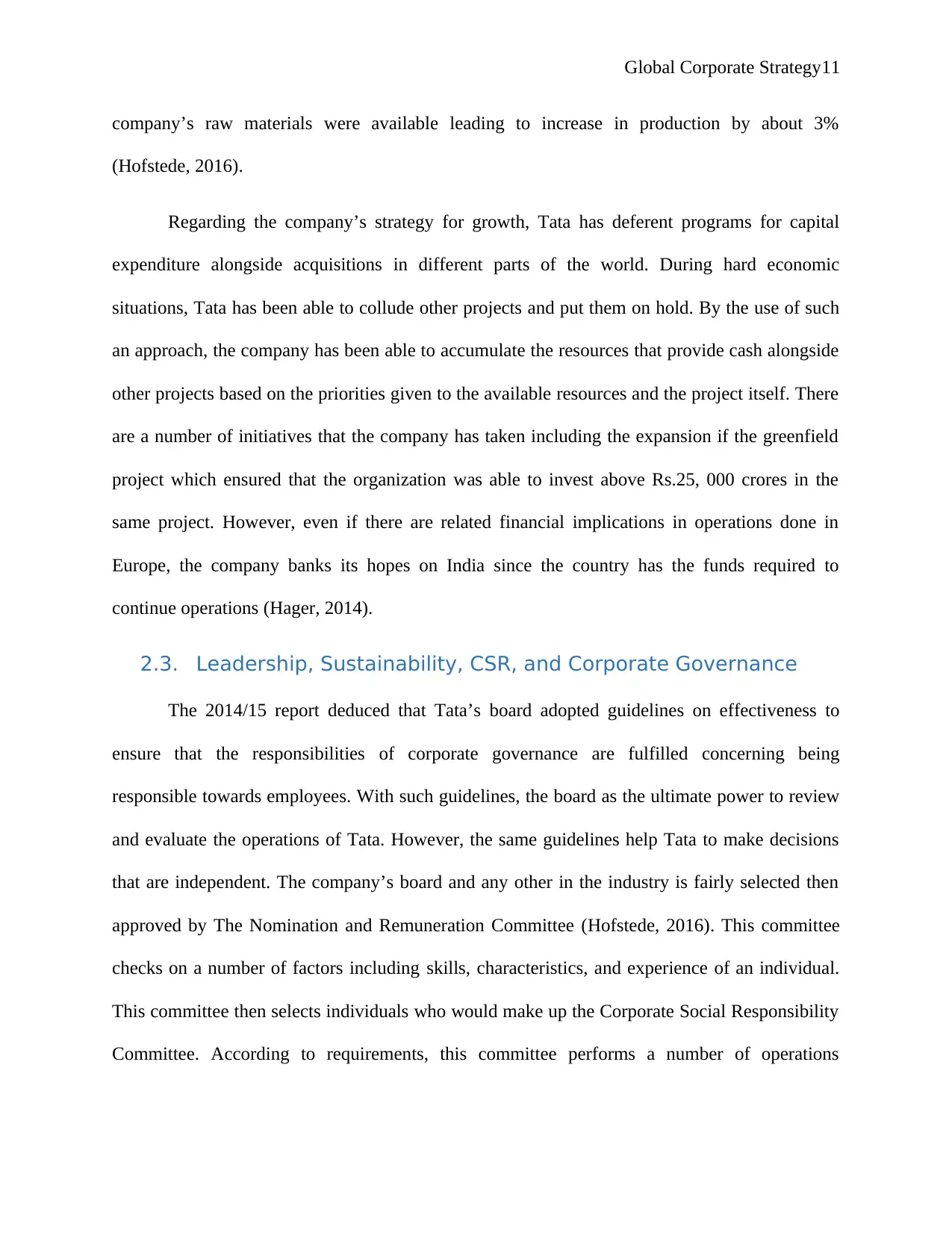
Global Corporate Strategy11
company’s raw materials were available leading to increase in production by about 3%
(Hofstede, 2016).
Regarding the company’s strategy for growth, Tata has deferent programs for capital
expenditure alongside acquisitions in different parts of the world. During hard economic
situations, Tata has been able to collude other projects and put them on hold. By the use of such
an approach, the company has been able to accumulate the resources that provide cash alongside
other projects based on the priorities given to the available resources and the project itself. There
are a number of initiatives that the company has taken including the expansion if the greenfield
project which ensured that the organization was able to invest above Rs.25, 000 crores in the
same project. However, even if there are related financial implications in operations done in
Europe, the company banks its hopes on India since the country has the funds required to
continue operations (Hager, 2014).
2.3. Leadership, Sustainability, CSR, and Corporate Governance
The 2014/15 report deduced that Tata’s board adopted guidelines on effectiveness to
ensure that the responsibilities of corporate governance are fulfilled concerning being
responsible towards employees. With such guidelines, the board as the ultimate power to review
and evaluate the operations of Tata. However, the same guidelines help Tata to make decisions
that are independent. The company’s board and any other in the industry is fairly selected then
approved by The Nomination and Remuneration Committee (Hofstede, 2016). This committee
checks on a number of factors including skills, characteristics, and experience of an individual.
This committee then selects individuals who would make up the Corporate Social Responsibility
Committee. According to requirements, this committee performs a number of operations
company’s raw materials were available leading to increase in production by about 3%
(Hofstede, 2016).
Regarding the company’s strategy for growth, Tata has deferent programs for capital
expenditure alongside acquisitions in different parts of the world. During hard economic
situations, Tata has been able to collude other projects and put them on hold. By the use of such
an approach, the company has been able to accumulate the resources that provide cash alongside
other projects based on the priorities given to the available resources and the project itself. There
are a number of initiatives that the company has taken including the expansion if the greenfield
project which ensured that the organization was able to invest above Rs.25, 000 crores in the
same project. However, even if there are related financial implications in operations done in
Europe, the company banks its hopes on India since the country has the funds required to
continue operations (Hager, 2014).
2.3. Leadership, Sustainability, CSR, and Corporate Governance
The 2014/15 report deduced that Tata’s board adopted guidelines on effectiveness to
ensure that the responsibilities of corporate governance are fulfilled concerning being
responsible towards employees. With such guidelines, the board as the ultimate power to review
and evaluate the operations of Tata. However, the same guidelines help Tata to make decisions
that are independent. The company’s board and any other in the industry is fairly selected then
approved by The Nomination and Remuneration Committee (Hofstede, 2016). This committee
checks on a number of factors including skills, characteristics, and experience of an individual.
This committee then selects individuals who would make up the Corporate Social Responsibility
Committee. According to requirements, this committee performs a number of operations
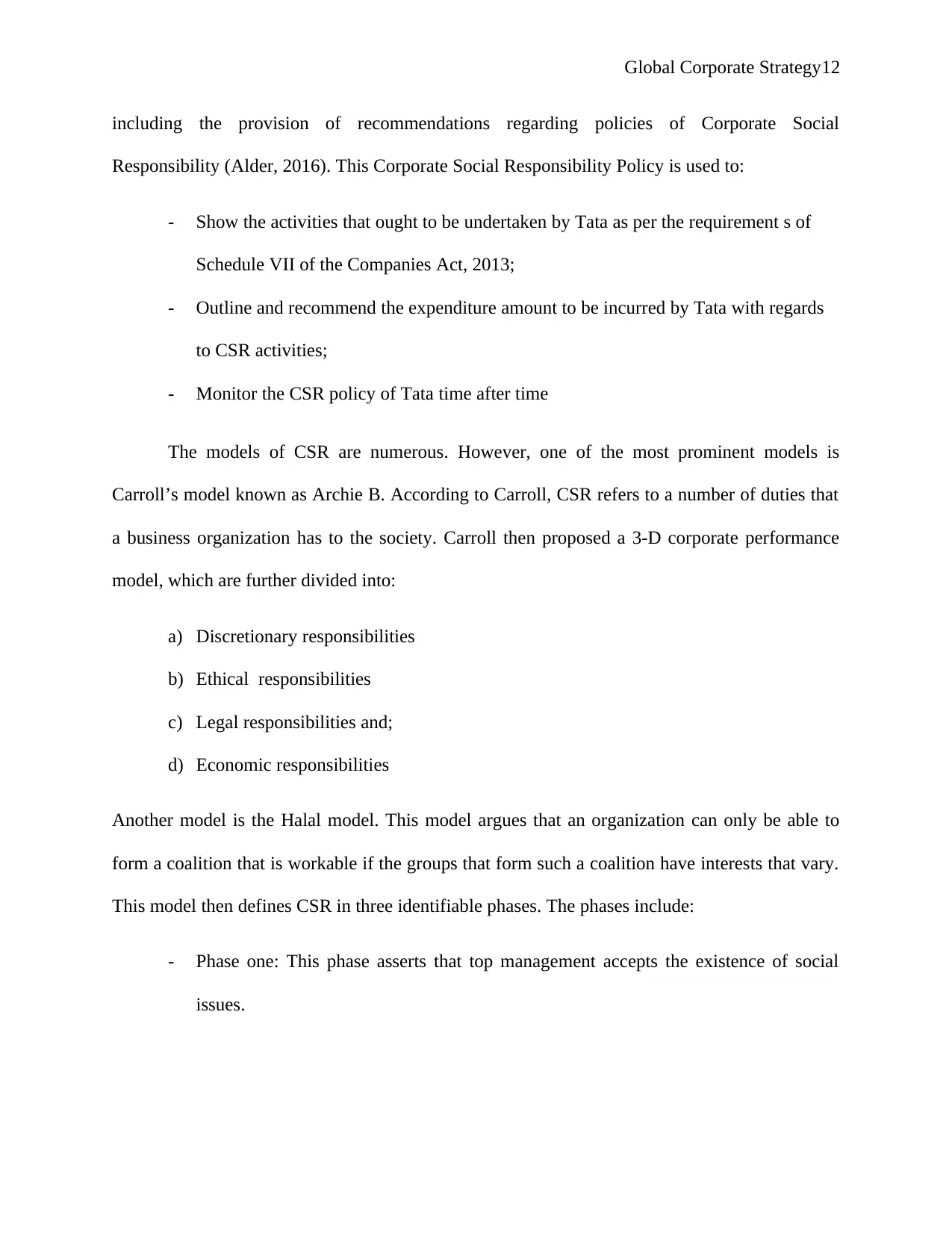
Global Corporate Strategy12
including the provision of recommendations regarding policies of Corporate Social
Responsibility (Alder, 2016). This Corporate Social Responsibility Policy is used to:
- Show the activities that ought to be undertaken by Tata as per the requirement s of
Schedule VII of the Companies Act, 2013;
- Outline and recommend the expenditure amount to be incurred by Tata with regards
to CSR activities;
- Monitor the CSR policy of Tata time after time
The models of CSR are numerous. However, one of the most prominent models is
Carroll’s model known as Archie B. According to Carroll, CSR refers to a number of duties that
a business organization has to the society. Carroll then proposed a 3-D corporate performance
model, which are further divided into:
a) Discretionary responsibilities
b) Ethical responsibilities
c) Legal responsibilities and;
d) Economic responsibilities
Another model is the Halal model. This model argues that an organization can only be able to
form a coalition that is workable if the groups that form such a coalition have interests that vary.
This model then defines CSR in three identifiable phases. The phases include:
- Phase one: This phase asserts that top management accepts the existence of social
issues.
including the provision of recommendations regarding policies of Corporate Social
Responsibility (Alder, 2016). This Corporate Social Responsibility Policy is used to:
- Show the activities that ought to be undertaken by Tata as per the requirement s of
Schedule VII of the Companies Act, 2013;
- Outline and recommend the expenditure amount to be incurred by Tata with regards
to CSR activities;
- Monitor the CSR policy of Tata time after time
The models of CSR are numerous. However, one of the most prominent models is
Carroll’s model known as Archie B. According to Carroll, CSR refers to a number of duties that
a business organization has to the society. Carroll then proposed a 3-D corporate performance
model, which are further divided into:
a) Discretionary responsibilities
b) Ethical responsibilities
c) Legal responsibilities and;
d) Economic responsibilities
Another model is the Halal model. This model argues that an organization can only be able to
form a coalition that is workable if the groups that form such a coalition have interests that vary.
This model then defines CSR in three identifiable phases. The phases include:
- Phase one: This phase asserts that top management accepts the existence of social
issues.
⊘ This is a preview!⊘
Do you want full access?
Subscribe today to unlock all pages.

Trusted by 1+ million students worldwide
1 out of 17
Related Documents
Your All-in-One AI-Powered Toolkit for Academic Success.
+13062052269
info@desklib.com
Available 24*7 on WhatsApp / Email
![[object Object]](/_next/static/media/star-bottom.7253800d.svg)
Unlock your academic potential
Copyright © 2020–2025 A2Z Services. All Rights Reserved. Developed and managed by ZUCOL.




